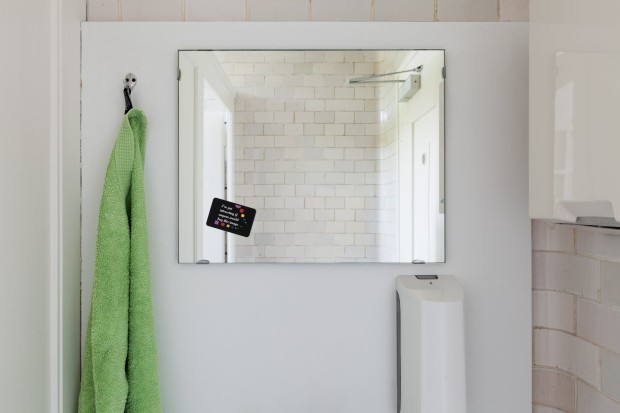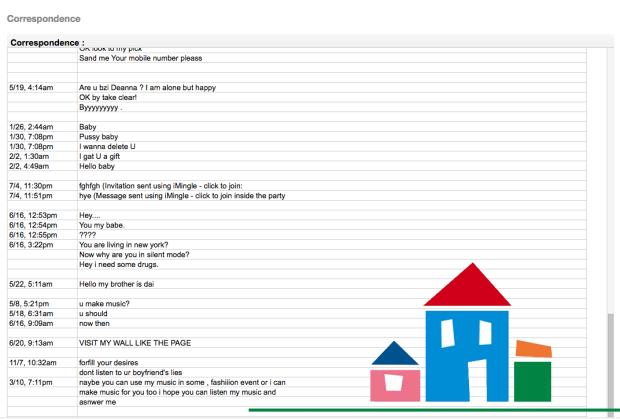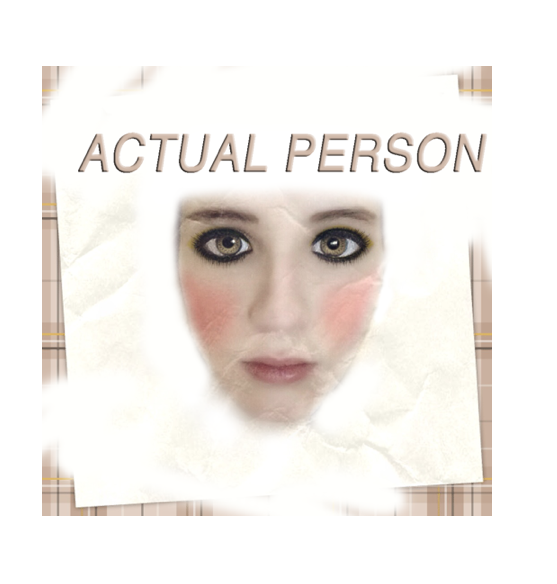
Deanna Havas. Photo: Marsha Owett.
A child of the nineties and bitmap programs, Deanna Havas has an almost scientific eye for default templates and aesthetic languages. In a brief image essay that she made for the online show All My Friends At Once, Havas recounts her childhood foray into the program Printmaster, “somewhat of an intermediary between KidPix and AdobeCS6.” The funny thing about the essay is, even at the age of seven, she was thinking about things like image rights.
Her investigations of templates have produced “Abject Aesthetics,” an Instagram board of default emo girl/body-shame aesthetics, and “Template Jams,” an e-book collage of wallpaper-y stock templates and watermarks.
Others examine funding mechanisms. For Rhizome’s “The Download,” Havas made a pay-per-click project “Affiliate Program” through which Rhizome members can get their donation returned by sending traffic to deannahavas.com. All they need to do is download Havas’s kit and set up their own affiliate site. It turns Rhizome members into traffic bots.
All of these studies add up to a cold, anthropological lens on our shared Internet languages. To analyze the psyche of an internet commenter, for example, Havas created “Actual Person”: an inner monologue through cliché message board confessions like “I cut off all my hair when he left me!” The list of confessions, desires, and emotions goes on and on for seventeen pages, until the outbursts reach a mind-numbing drone. “I want to fucking die” gets utterly lost in the banality with statements like “I fold Origami.” Whether it’s IMs or default banners, Havas seems to suggest that these are the tools by which identities are shaped and masked.
1. What defines a good artist?
The institution!
2. Who and what influences your work?
Communication, autonomy, exchange, making, Wikipedia, my room, Glaxosmithkline, anthropomorphism, coffee, merle pattern sweaters, boredom, list-journalism, plastic, Urban Outfitters, alchemy, social media, professionalism, narcissism, Adobe Creative Suite, neoliberalism, spam, ontology, the artist as archetype, globalization, boys, shopping, parties, whatever, NYC, fantasy, Morrissey, Contemporary Art Daily, poverty, translation errors, woven fabrics, critical theory, the ocean, abstraction, research, Lil b, “the 90s,” multiculturalism, Apple, alienation, puppies, programming, otherness, industry, Juice Press, positivism, James Blake, my BFA, semantics, systems, insecurity, ideology, weed, Buzzfeed quizzes, management, frequent flier miles, teen quotes, anxiety, rap, romance, neet-freeterdom, celebs, travel, overdraft fees, composite materials, unfollowers, craft stores, my team, my network, myself…
3. What interests you about words that live online?
The indexable nature of online text is the most useful aspect, maybe even the most interesting.
Huh?
I’m not really sure what else to say? Essentially, Google indexes words, they are assigned a value, the value equates to financial capital and then there is some infrastructure built on top to capitalize off of this system. Content doesn’t matter as much as views or impressions do. You could even argue that meaning gets in the way because it slows this process down. There is a negating effect. Thats why clickbait exists and why spam is so pretty—it’s representational.
Also online words are cheaper than print media and I don’t like talking on the phone. Why does anyone care about words online?
4. What gender is the Internet?
Rule 30 of the internet states “There are no girls on the internet.”
5. In your series “Abject Aesthetics” you present Pinterest boards with images and text about depression, anxiety, and relationships gone awry. A lot of the text is heartfelt, but isn’t trying to be poetic. It’s memorable without being remarkable. Often, the images function similarly—a butterfly behind depressive text, a woman in a bathtub, nature scenes, etc—but I was struck by the number of reddened or bloody knees. What was the rationale behind the images you pinned? What is your process?
My process and function changes with each project. I guess that can be interpreted as either intuitive or methodical? They’re sort of case studies. I try to consider subjectivity, scale, and perspective in the creative process differently each time, and of course, form changes along with that. Sometimes I am more extraneously compelled to make something.
“Abject Aesthetics” was informed by the presence of fandoms and communities on Tumblr that consecrate the abject. I pulled from bruise blogs, Columbiners, and Pro-ED, to name a few. Some of these communities I remember predating web 2.0, so I tried to refer to my own experience while collecting images for my board. I felt Pinterest, as a platform, better emphasized the parallel between this process and “mood-boarding” in design industries such as fashion. As a tool, mood boards also anticipate the dissemination of a message onto a new platform.
It is an open project so I add to it from time to time, although admittedly I haven’t had the chance for some time now.
6. What does it mean to be a millennial? You talk about being confused over why some images were free and others weren’t in your essay for Gene McHugh’s All My Friends at Once. Was that a defining moment for you in some way, or simply a moment which could be defining?
To be a millennial means to be the labor reserve while simultaneously a manager of contingencies.
I think coming to terms with proprietary content is a milestone in anyone’s life who works with digital content.
7. Do you see yourself living in New York for the next five to ten years?
Yes, for better or for worse. Ideally, I would like to have homes in various major cities around the world, but I grew up in New York so I always have a home here.







{ 1 comment }
Great artist and will flake on a coffee appointment with a fan to appease her family.
Comments on this entry are closed.